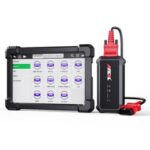Enhanced automotive scan tools often come equipped with bi-directional control capabilities, yet many technicians and DIY enthusiasts primarily utilize them for reading diagnostic trouble codes and examining parameter data. Bi-directional control refers to the two-way communication between devices, enabling an OBD2 scan tool to not only receive information from a vehicle’s computer system but also to send commands to perform specific tests and functions. You might also hear bi-directional controls referred to as actuator tests, functional tests, or system tests. Reprogramming functionalities also fall under the umbrella of bi-directional controls.
A bi-directional scanner stands apart from a standard OBD2 scanner due to this command capability. Instead of merely retrieving data, these scanners actively engage with the vehicle’s computer, embodying the essence of bi-directional control. Through active tests, mechanics can pinpoint operational issues effectively. For instance, bi-directional controls can be employed to toggle relay fans or fuel pumps on and off, facilitating the diagnosis of operational abnormalities.
Below are examples of bi-directional tests supported for a 2016 Chevy Silverado V8 5.3L engine, as per our coverage checker. Note that bi-directional testing is supported by our 5610, 5160RS, and tablet models.
Note: https://www.innova.com/pages/coverage
The video above demonstrates the bi-directional capabilities of the Innova 5610, showcasing a purge valve diagnosis in action.
Another instance of a bi-directional active test performed by the Innova 5610.
